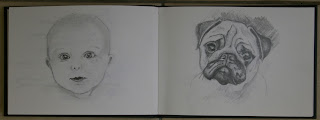Task 1 (project 8)
Critical Statement
Task 1 (Project 8)
I chose the subject of a panting and fearful pug because I wanted to say something about the suffering of these animals which has been caused by selective breeding for certain characteristics which people find appealing. Their flat faces and small noses in particular, cause breathing problems.
My colour choices were bright in order to reflect a pop art aesthetic because these dogs are fashionable commercial products. I selected shades of blue and purple because I wanted to reflect the colours of cyanosis when the skin and tongue take on a bluish tinge because of lack of oxygen.
I used a cropped composition, which doesn’t include the whole face of the dog. My aim with this was to not allow any breathing space around the subject and to give a feeling of claustrophobia.
The final prints are successful in some aspects. The registration and the transfer of ink is good so technically I think the execution is acceptable. The main fault with the execution is the failure to adequately clear the lino in non printing areas. Because I have been consistent in the direction of my clearing marks I don’t think it’s a major problem I the background area on the left side of the print. In fact, I quite like these marks. However, in the upper right corner, these marks overlie the subject and I thick that these marks detract from the print.
The colour choices I made were not ideal because I don’t think that there is sufficient tonal difference between the second and third colours.
Overall I don’t think this communicates my concept quite clearly enough. My vet colleagues get the point when shown the image along with the title. However, the image on its own could just be pretty picture of a pug which has been poorly composed and printed in nice bright colours. To communicate a negative concept it may be necessary to make the imagery more grotesque but then it may become too obvious. It is difficult to find a balance.
Task 2 (project 9)
Critical Statement
Task 2 (Project 9)
Prints are presented which contain marks made in various experimental ways on the lino.
Marks have been made using a pocket-knife, screws, nails, a wire cutter, a cheese grater and a lemon zester. On a separate plate, a variety of marks have been made using a dremel with various heads and drill bets.
Further experiments in mark making consist of lino etched after the application of wax and lino etched multiple times. Some of these have been overprinted on top of each other in multiple colours.
Task 3 (project 10)
Critical Statement
Task 3 (Project 10)
I have produced two different prints for this part. The first ‘fur baby’ is a type of chimera combining human and canine features. This is informed by an extreme type of anthropomorphism which leads people to select ‘designer’ pets which share certain physical features with human babies making them appealing on a basic evolutionary level and securing their place as a child substitute in many modern households. However, natural evolution has little to do with the occurrence of these animals because they are selectively bred by humans for traits which in the natural world would constitute a distinct disadvantage to their survival.
I selected bright colours because I wanted to reference pop art as this is a comment on commercialisation and commodification of animals. I used a combination of techniques with reduction cutting on the coloured block and lino etching on the ‘key’ block. I pulled the prints by hand burnishing. Considering this, I think the transfer of ink is adequate. There are however, some technical issues, in particular with the registration.
I wanted to reading of this print to be somewhat ambiguous because the issue is a complex one and not black and white. These animals are cute and they are mainly well cared for as a result of the anthropomorphic way in which their owners relate to them. However, I strongly disagree with the breeding practices, which have brought about their existence and the acquisition of them by people who want them because they are the latest ‘must-have’ fashion accessory. I think this is partially successful because people who I have showed it to have described it as disconcerting. It is both ugly and cute. There is an attraction and revulsion. The image is grotesque but not to the extreme of ugliness.
The second print is of a rooster. Although I have many ideas about chickens and their place in society, which I would like to explore more fully, this particular print was inspired mainly from a photographic source in which I was fascinated by the texture of the comb and wattles. My main aim was to try to reproduce the texture and to attempt to convey the somewhat challenging or menacing look in this rooster’s eye – although this is indulging in blatant anthropomorphism.
The texture has been achieved using lino etching and a resist. I think this is successful. I also like the mark making I have achieved on the second plate with various tools. However, there are some technical issues with the print. I selected complementary red and green because I thought it would add to the impact of the print but I think that perhaps their tonal values are too similar which reduces the tonal variation and therefore the impact of the final print. There are also problems with registration again.
Overall I think I have fulfilled the requirements of the tasks but there are lots of areas which could be improved.














































